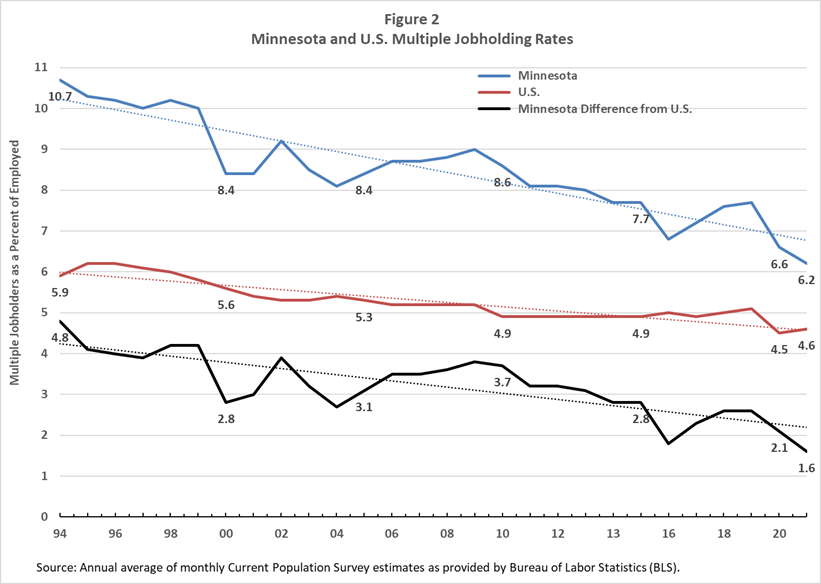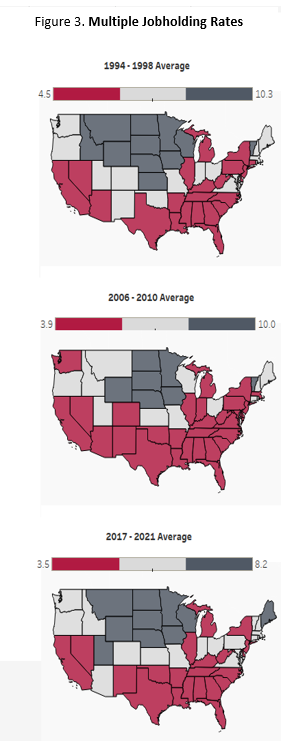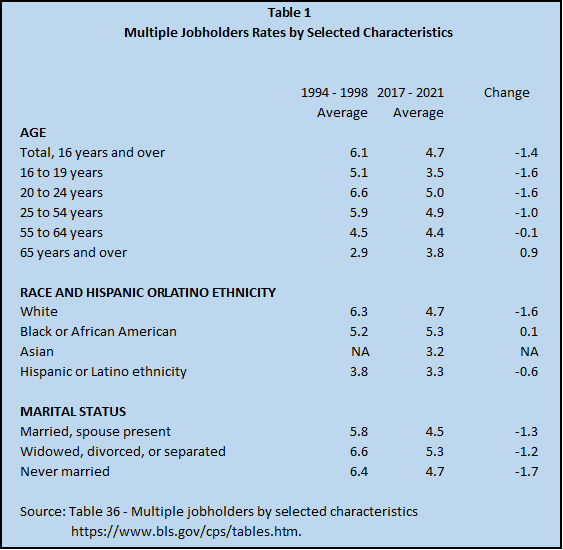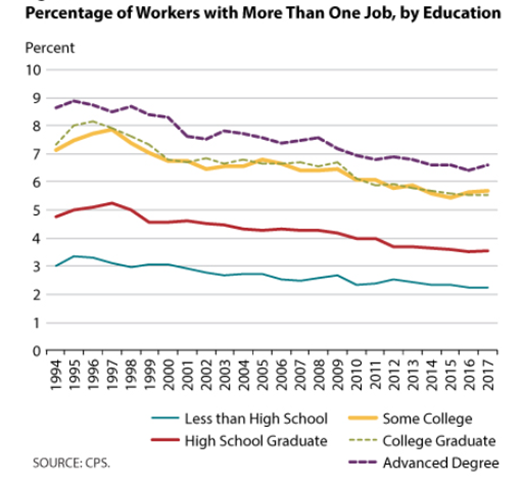
by Dave Senf
December 2022
The number of individuals employed in the U.S. has rebounded 17.5% since April 2020 on a seasonally adjusted basis, while the number of individuals with two or more jobs, or multiple jobholders, has spiked 39.6% over the same period (April 2020 to October 2022). With inflation continuing to remain high, real wages decreasing and pandemic savings diminishing, roughly 2.1 million individuals across the country have moved into moonlighting since April 2020 to earn extra income and perhaps cover day-to-day expenses.
That is only part of the story though, since the number of individuals with multiple jobs is, unlike total employed nationally, still below pre-pandemic levels. Even though multiple jobholding has grown more than twice as fast as overall employment since the height of Pandemic Recession job loss, the number of multiple jobholders in October was at 7.5 million compared to 8.3 million in January 2020. Multiple jobholding plunged more during the Pandemic Recession than total employment (-33.1% versus -16.0%), leaving multiple jobholders accounting for 4.7% of all employment in October, down from 5.2% in January 2020 according to the Bureau of Labor Statistics (BLS) using Current Population Survey (CPS) responses (see Figure 1).1

There are no monthly estimates of multiple jobholding in Minnesota (or any other state), since the number of Minnesota households interviewed monthly for the national CPS is too small to yield statistically reliable monthly estimates at the state level. The BLS has however been publishing annual estimates of multiple jobholders for states since 1994 (see Figure 2). According to the BLS estimates, the percent of multiple jobholders as a percent of employed in Minnesota declined in 2020 and 2021 after having increased from 2017 through 2019.
The U.S. annual multiple jobholding share will likely inch up in 2022 given the rise in the rate nationally through the first ten months. Minnesota will likely also record an annual uptick in its multiple jobholding rate in 2022 given how tight the state's labor market has been over the last year. Job availability (how easy jobs are to find) may play as large a role in multiple jobholding as workers' desire or need for a second job. Job vacancy rates have remained elevated throughout 2022, making it easy for jobseekers to find jobs.
The pandemic-caused decline in multiple jobholding as a percent of employed accelerated a three-decade trend of declining multiple jobholding in Minnesota and across most of the U.S. (see Figure 2 as reported by the BLS based on CPS responses). Minnesota's moonlighting numbers have fallen off faster than nationally, slipping from above 10% in 1994 to 6.2% last year. In 1998 267,000 Minnesotans held more than one job, compared to 180,000 in 2021 according to BLS data. Moonlighting in the state, which used to be nearly five percentage points above the national rate, fell to only 1.6 percentage points higher than the national rate in 2021. In other words, Minnesota's multiple jobholding rate was 80% higher than nationally in 1994, but only 35% higher in 2021 according to CPS data.

 Minnesota, along with the other Northern Plains and Rocky Mountain states, have consistently had the highest multiple jobholding rates over the last three decades (see Figure 3). All but two of the 50 states have seen their rates slowly decline over time, but higher rate states have tailed off faster, reducing the gap between the average 10 highest and 10 lowest rate states from 6.7 percentage points in 1994 to 4.7 percentage points in 2021.
Minnesota, along with the other Northern Plains and Rocky Mountain states, have consistently had the highest multiple jobholding rates over the last three decades (see Figure 3). All but two of the 50 states have seen their rates slowly decline over time, but higher rate states have tailed off faster, reducing the gap between the average 10 highest and 10 lowest rate states from 6.7 percentage points in 1994 to 4.7 percentage points in 2021.
Higher concentrations of farm employment, lower unemployment rates, and higher multiple jobholding rates in rural areas explain some of the regional variation in multiple jobholding rates. States with high multiple jobholding rates are more rural than most states. Many individuals working on small and median size farms or ranches also hold off-farm jobs to supplement their farm income. Rural areas in the high multiple jobholding states also tend to have low unemployment. Low unemployment rates typically mean labor demand is high relative to supply, creating ample opportunities for landing a second job.
The common view is that multiple jobholding is countercyclical, increasing when economic downturns arrive and decreasing when the economy is expanding. The relationship between multiple jobholding rates and business cycles has actually been shown to be ambiguous, since two countervailing forces are always in play.
During expansions unemployment rates fall, labor markets tighten up, and job openings become relatively more plentiful. Thus, multiple jobholding rates may increase as second jobs are easier to find. At the same time, though, individual interests in working another job may lessen as both work hours and pay increase during expansions, reducing the need to supplement household income by moonlighting.
The availability of jobs, and the desire to hold a second job, reverse directions during recessions. Unemployment increases, job openings diminish, and the availability of jobs decreases. At the same time, falling or stagnant income may motivate more individuals to look for a second job. As displayed in Figure 2, there is little change in multiple jobholding share during recessions or expansions at the national level, especially when compared to unemployment rate swings. Minnesota's rates show more annual variation, but the changes don't consistently match with up economic swings.2
Many aspects of the Pandemic Recession and the ensuing two years don't conform to past recessionary periods, including multiple jobholding rates. The steep decline in Minnesota's rate in 2020 makes sense, as the opportunity for multiple jobs and the desire to hold more than one job was subdued for the first half of 2020 as individuals were asked to stay home to mitigate the spread of COVID-19.
But the slight drop in 2021 is a puzzle. Labor markets gradually tightened through 2021 (signaling more opportunity for second jobs) and concern over COVID-19 lessened, (perhaps increasing the desire to hold a second job) which should have produced an uptick in the state's multiple jobholding rate like what occurred nationally. The inconsistent annual changes in Minnesota's multiple jobholding rate may just be a result of the small number of Minnesotans interviewed in the CPS and surveying problems associated with the pandemic.
A higher percentage of residents with high school diplomas than the national average, higher female labor force participation rates and higher part-time-employment rates may also contribute to the high rates of moonlighting in states like Minnesota, South Dakota, and North Dakota.3 States with high multiple jobholding rates tend to have high female labor force participation rates and high rates of part-time jobs. Some analysts see above-average moonlighting, female labor force participation, and part-time employment as indicators of stronger-than-average work ethic. Higher-than-average multiple jobholding rates may just be a byproduct of a strong work ethic.
Up until the mid-2000s, multiple jobholding rates were the same for women and men. Since then, women's rates nationally have tapered off less than rates for men, averaging 0.8 percentage points higher the men's rate over the last five years. The female rate topped the male rate 5.0% to 4.3% in 2021. Published national multiple jobholding rates by other demographic characteristics are summarized in Table 1.
Most demographic groups have experienced falling multiple jobholding rates over the last three decades. Only one demographic group, workers aged 65 years and older, are moonlighting more today than in the past.4 Multiple jobholding rates have held constant over the past 30 years for 55 to 64 year olds and for Black or African American workers.

Multiple job holding across education attainment level may surprise some as CPS data shows multiple job holding rates increase with education, countering the perception that moonlighting is concentrated mainly among low-wage workers struggling to make ends meet (see Figure 4).

Interestingly, workers with advanced degrees in 2017 were moonlighting at more than 3 times the rate of workers with less than a high school education (6.7% versus 2.2%), and almost twice the rate as workers with a high school diploma (3.6%). Multiple job holding rates across all education levels, similar to most demographic categories, have been declining over time.
The 6.2% rate of multiple jobholding in Minnesota in 2021 seems low given numerous reports in the news of workers holding two or more jobs to get by. Since the 180,000 estimate is an annual average figure based on monthly CPS responses, the number of Minnesotans who at some time last year had more than one job could be much higher. For example, 180,000 workers held two jobs during the first six months while another 180,000 workers held two jobs during the second six months of the year. Under this scenario, the 180,000 is still the annual average estimate, but 360,000 Minnesotans were multiple jobholders during some time last year.
Moonlighting estimates may also be part of the puzzle of measuring self-employment. Multiple jobholding, as with self-employment, seems to be everywhere but in the data.6 Survey responses may not be fully capturing the extent of multiple jobholding.
Recent research linking individual IRS data and CPS responses show an increase in the share of individuals reporting self-employment income in the IRS data, but not in the CPS data, implying that CPS estimates of self-employment may be on the low side. Similar research examining multiple jobholding using administrative data tell a different story than the CPS story of declining multiple jobholding.
The Longitudinal Employer-Household Dynamics (LEHD) database, which links wages and salaries reported for Unemployment Insurance purposes with individual demographic data from various sources shows multiple jobholding is becoming more important in the labor market, rather than less as the CPS measure implies. Based on the LEHD dataset, U.S. multiple jobholding rates increased from 6.8% in the second quarter of 1996 to 7.8% in the first quarter of 2018, on a seasonally adjusted basis.7
Multiple jobholding using LEHD data defines a multiple jobholder as anyone who holds two jobs in a quarter and at least one of those jobs is a stable job held in the previous, current, and subsequent quarters. The jobs held are wage and salary jobs only, with the multiple jobholding rate being the number of multiple jobholders divided by total number of employed persons. The difference in LEHD and CPS estimates of multiple jobholding rates really aren't surprising since one is a quarterly estimate while the other is a monthly estimate. A worker who takes vacation time from their full-time job to work at the Minnesota State Fair would be classified as a multiple jobholder in August and September in CPS data, but not July, yielding an average multiple jobholding rate of two-thirds for the three months. That same worker would have a multiple jobholding rate of one for the three months using the quarterly LEHD definition. The difference in level between CPS and LEHD is expected, thus the diverging trends of the two measures over time is what is interesting.
Another significant difference between the two multiple jobholding estimates is that the LEHD estimates exhibit distinct cycle patterns unlike the CPS estimates. The LEHD multiple jobholding rate is pro-cyclical, clearly rising during economic expansions and falling during recessions, countering reports of increasing instances of multiple jobholding during downturns.8
The multiple jobholding gap between women and men is higher using LEHD data, with 9.1% of females holding multiple jobs during the first quarter of 2018 compared to 6.6% for males. LEHD data, like CPS data, shows that the gender gap has been gradually increasing. But LEHD rates, unlike CPS rates, have been increasing across all age groups. The relative ranking of rates across age groups are similar in the two datasets.
The LEHD data also show that multiple jobholding is very seasonal, with the lowest rates posted during the first quarter and then increasing each quarter before peaking in the fourth quarter. CPS estimates also show similar seasonality, but not to the same extent. LEHD data includes data on earnings for an individual's primary and secondary jobs. The data show that earnings from secondary jobs has averaged 27.8% of multiple jobholders' total earnings since 1996, with little change over the years.
Secondary job earnings as a percent of total earnings are highest for workers with lower total earnings, but the percent remains near the overall 27.7% average for workers earning across the 10th and 90th percentiles of total earnings. Low earning workers are also more likely to hold multiple jobs than workers with higher total earnings (workers in the lowest 10th percentile of total earnings have multiple jobholding rates slightly above 11%, compared to 7% for workers in the highest 10%).
The new LEHD-based national multiple jobholding measures have added to the discussion of the importance of moonlighting to U.S. labor markets, especially in light of the difference between the survey-based CPS and administrative data-based LEHD estimates. Further clarification of the importance of multiple jobholding in Minnesota, and other states, will soon be available as the multiple jobholding researchers using LEHD are working on providing state level measures. These new multiple jobholding measures for states will reveal if the difference in state rates identified using CPS data hold using LEHD, expanding on the factors behind varying rates across states. Analysis of LEHD-based multiple job holding data for Minnesota will be conducted by DEED when it becomes available.
1The Current Population Survey (CPS) is the monthly survey of households conducted by the U.S. Bureau of Census for the Bureau of Labor Statistics. Its main purpose is to allow the BLS to produce monthly unemployment estimates but it also provides information on the labor force, employment, persons not in the labor force, hours of work, earnings, and other demographic and labor force characteristics.
3"Multiple Jobholding Revisited: Why is it a Regional Phenomenon", David Bullard, Wyoming Department of Employment, Research & Planning
4See CPS Annual Average Table 36 - Multiple jobholders by selected characteristics
5Reproduced from Stéphane Auray, David L. Fuller, and Guillaume Vandenbroucke, "Multiple Jobholders," Economic Synopses, No. 32, 2018.
6The article "In Search of the Independent Contractor
7More information on LEHD, which forms the base for the Quarterly Employment Demographics tool at DEED's website.